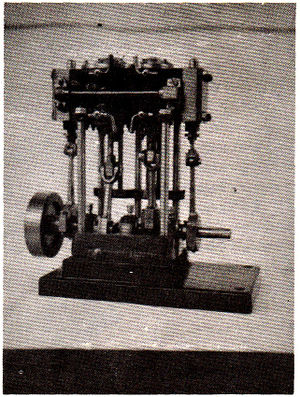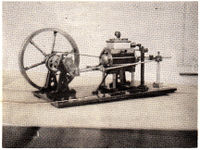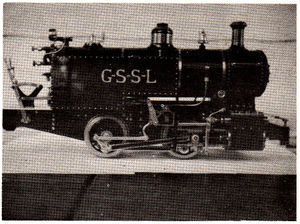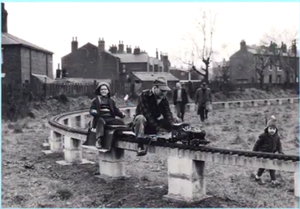Getting Started
by Major Douglas T. Peck
The North American Live Steamer, Volume 1 Number 11, 1957
Judging by a number of letters I've seen in The North American Live Steamer, I believe there is a large group of beginners who are attracted by the live steam hobby but who don't quite know how to go about getting started. I can sympathize with them! Having just gone through the first halting, hectic months of getting started in this most interesting hobby, I believe I can offer a few suggestions that will help. Here they are.
First, gather material about live steam and live steamers. All you can get your hands on. First on the list will be a file of The North American Live Steamer. Then send for all the catalogs advertised in the NALS. You'll need a complete file of catalogs since each advertiser specializes in a slightly different line of castings and equipment. In these catalogs you will see a book called The Live Steam Book by LBSC. Buy it! It's your bible for live steam. Try the local library - you'll find many interesting books on steam development and history. Get Pioneer Railroads by Hank Bowman. This is a complete reference book on early railroads obtained from Fawcett Books, Greenwich, Conn. for only 75 cents. Popular Mechanics has also published a good paper back Railroad Album that sells for only $1.00. Build up a live steam reference library composed of the NALS, pictures, plans and books. By now you will be itching to get started on a locomotive or perhaps a traction engine - but wait! Don't rush!
Here's my proposal. It worked fine for me and it'll do the same for you. Work into a locomotive gradually by building a couple of stationary engines. These little engines will be fun to build and run and will give you the feel for handling steam. I'm assuming you have some mechanical aptitude or you wouldn't be attracted to live steam in the first place. However, you'll find that little techniques of the trade - like correct tolerances for expansion, jointing and sealing for your piping, valve timing, etc. will be new and different from what you've been accustomed to in your other work or in normal internal combustion engine practice.

Illustrated in Figure 1 is a double acting compound marine type engine that I built from a casting kit obtained from the Charles Cole catalog. An engine similar to this makes an excellent project on which to experiment and make mistakes. Mistakes made on this engine (and don't feel bad - everybody makes em!) will be far less costly and frustrating than when made on a locomotive. Cole now has a beam engine that would probably be an even better engine to start on and would be a beauty to behold when finished.
Next, you might try a free lance engine. This will give you practice in fabricating and building up parts from raw stock. Shown in Figure 2 is such an engine; a 3/4 inch bore double acting engine modeled after an agricultural pumping engine of about 1830-1840 vintage. Get your ideas for this from your live steam reference library. Small stationary engines like these serve as excellent stepping stones to a locomotive.
Now you are ready to tackle a locomotive. Consider the gauge carefully. There have been a number of articles in NALS putting forth the virtues of the different gauges. Dig them out and re-read them. I selected 3-1/2 inch gauge (3/4 inch scale) since this size is small enough to be easily transported, yet large enough to haul myself and perhaps a few kids around the backyard. Select the type of locomotive carefully. Hold your desire for a Pacific or Hudson until later. Try an 0-4-0 or 0-6-0 switcher as a starter. First buy only the blue-prints and carefully go over them. You can then tell whether your lathe can handle the job and whether or not it is really the job you wanted. if you decide then that this particular locomotive is not quite what you wanted, you are only out the price of the blueprints and they will be valuable to add to your live steam library.
You will have learned from building the stationary engines that in addition to your basic hand tools a goodly supply of small taps and dies is a must. Here I strongly recommend you investigate the English BA and ME series of small taps and dies. The range in sizes is greater than commonly available in US taps and dies and the thread depth and pitch is more compatible to the small screw sizes. These taps and dies will enable you to fit and use the many fine English fittings advertised in most model catalogs. You may want to obtain a good supply of the many fine catalogs put out by English model firms. You'll find particulars in the English magazine Model Engineer. This magazine itself will also be a valuable adjunct to your live steam library.
You will get some idea of the amount of shop equipment necessary in building the small stationary engines. I have what I feel is absolute minimum shop equipment for 3-1/2 inch gauge - a six inch lathe with milling attachment, a 1/4 inch hand drill with drill press attachment and a propane torch for brazing and silver soldering. Notice I said this was "minimum" equipment. If you can possibly swing it, get a bench drill press with 1/2 inch capacity, at least a 9 inch lathe and a bench grinder. As you get into the larger gauges you will need more and larger equipment.
Well, those are my hinds for "getting started". From here on in you're on your own. My main points are:
- First - build up a good live steam reference library
- Then - ease into a locomotive by first building a couple of simpler stationary engines.
It's worked fine for me. To prove it, here is my baker valve, 3-1/2 inch gauge, 0-4-0 tank switcher, finished except for the cab (see Figure 3). This is the first of a large stock of engines to run on the Gulf Southern Short Line. Don't wait any longer! get started now!
- Major Douglas T. Peck
- 3344 Cloverdale Rd
- Montgomery 6, Alabama


